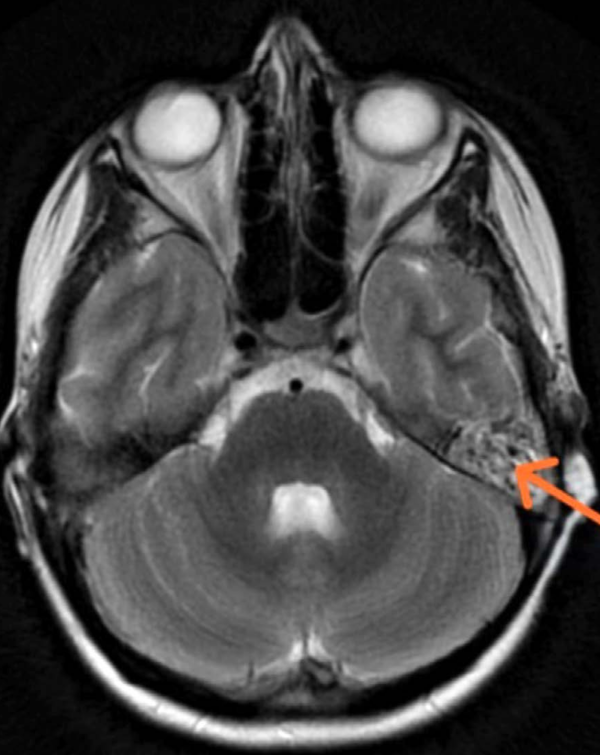Resumen
Introducción. Las otitis medias son una patología frecuente en edad pediátrica, habitualmente con un curso benigno, realizándose manejo sintomático y observacional en muchos casos en pacientes sin factores de riesgo. Sin embargo, existen complicaciones potencialmente graves de las otitis medias, siendo la más habitual la mastoiditis, aunque existen otras.
Caso clínico. Presentamos el caso de una paciente de 9 años con antecedente de otitis medias de repetición que desarrolló como complicación de una de ellas una apicitis petrosa o síndrome de Gradenigo. Presentaba diplopía aguda y cefalea cuando consultó en el servicio de Urgencias Hospitalarias. Tras la realización de la confirmación diagnóstica por técnicas de neuroimagen la paciente recibió tratamiento antibiótico intravenoso con resolución clínica y de pruebas complementarias en el seguimiento posterior
Conclusiones. La presencia de focalidad neurológica aguda, fundamentalmente afectación de los nervios motor ocular externo y trigémino, en su porción sensitiva, en un paciente con antecedentes de otitis medias de repetición, o una otitis media activa, deben hacer sospechar la presencia de un síndrome de Gradenigo. La correcta identificación y tratamiento antibiótico precoz en nuestro
caso facilitó una resolución satisfactoria sin recurrir a mastoidectomía.
Referencias
Rossi N, Swonke ML, Reichert L, Young D. Gradenigo's syn- drome in a four-year-old patient: a rare diagnosis in the modern antibiotic era. J Laryngol Otol. 2019; 133(06): 535-7. https://doi.org/10.1017/S0022215119001026
Gore MR. Gradenigo's syndrome: A review. Ann Med Health Sci Res. 2018; 8(4): 220-4.
McLaren J, Cohen MS, El Saleeby CM. How well do we know Gradenigo? A comprehensive literature review and proposal for novel diagnostic categories of Gradenigo's syndrome. Int J Pediatr Otorhinolaryngol. 2020; 132: 109942. https://doi.org/10.1016/j.ijporl.2020.109942
Pont E, Mazón M. Indicaciones y hallazgos radiológicos de la otitis media aguda y sus complicaciones. Acta Otorrinolaringo- lógica Esp. 2017; 68(1): 29-37. https://doi.org/10.1016/j.otorri.2016.02.012
Brambilla A, Pasti M, Parri N. Sudden diplopia at a Pediatric Emergency Department: A case of Gradenigo syndrome in a child. Pediatr Emerg Care. 2019; 35(12): e236-7. https://doi.org/10.1097/PEC.0000000000001684
Bano S, Nawaz A, Asmar A, Aemaz Ur Rehman M, Farooq H, Ali H. Gradenigo's syndrome presenting as IX and X cranial nerve palsy without clinically apparent ear infection: A case report and review of literature. eNeurologicalSci. 2022; 27: 100397. https://doi.org/10.1016/j.ensci.2022.100397
Chan KC, Chen SL. Diplopia in a child: Gradenigo syndrome is an unforgettable disease. Ear Nose Throat J. 2023; 102(2): NP53-5. https://doi.org/10.1177/0145561321989459
Savasta S, Canzi P, Aprile F, Michev A, Foiadelli T, Manfrin M, et al. Gradenigo's syndrome with abscess of the petrous apex in pediatric patients: what is the best treatment? Childs Nerv Syst. 2019; 35(12): 2265-72. https://doi.org/10.1007/s00381-019-04352-4
Rossor TE, Anderson YC, Steventon NB, Voss LM. Conservative management of Gradenigo's syndrome in a child. BMJ Case Rep. 2011; 2011: bcr0320113978. https://doi.org/10.1136/bcr.03.2011.3978

Esta obra está bajo una licencia internacional Creative Commons Atribución-NoComercial 4.0.
Derechos de autor 2024 Boletín de Pediatría
